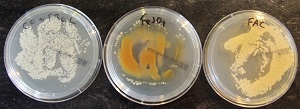

What is ‘biorational’?
The term ‘biorational’ is fairly new and describes agrochemicals that work in synergy with beneficial organisms. It was initially used to describe a new generation of insecticides that were developed to work alongside biocontrol insects without harming them. Crucially, while biorational products can be used to reduce the environmental impact of farming, and some products are organic, they are not synonymous with organic products.
While biorational pesticides have been in development for over a decade, biorational fertilizers are not as widespread. However, there are many advantages of using a biorational fertilizer. Most importantly they work in synergy with the plant’s microbiome by feeding and/or not killing beneficial microbes. These beneficial microbes will in turn enhance the growth of the crop (for full details see the previous post under Mode of Action).
Clearly using biorational fertilizers is advisable when growers are applying microbial inoculant products (such as rhizobia and mycorrhizae) but in addition there is hardly any form of growing plants that does not see benefit from beneficial microbes being stimulated, even if it goes on unknowingly to the farmer/grower! Therefore, using biorational fertilizers and pesticides allow you to have multiple tools working to maximise nutrient and pest management.
Promoting microbes
Energy sources promote the growth of most beneficial microbes. This is because the vast majority of soil bacteria and fungi species are saprotrophic, feeding off decaying organic matter or exudates from roots. Simple sugars can be used to supply energy, but be careful not to over-apply as the resulting aerobic metabolism could lower soil oxygen leading to anaerobic conditions which will be harmful to both plants and the aerobic microbes. You also do not want to stimulate facultative saprotrophic pathogens (e.g. honey fungus and Botrytis) or if foliar applied, stimulate sooty moulds on foliage.
Other fertilizer ingredients that also provide a source of energy to microbes include ammonium, nitrates, urea, potassium, phosphorus, sulphur, humic acids, seaweed extracts, chelating agents and the organic matter present in organic fertilizers.
As well as using nitrates and ammonium as an energy source, microbes also require nitrogen for protein production. As a result, optimizing the C:N balance is essential for both optimal plant and microbial growth.
Nutrients. Some chemical elements are required by all life on Earth, while others are specific to certain groups. The elements required by plants will already be in most fertilizers on the market. As a result, if you want to promote beneficial microbes you may want to add extra nutrients of those specifically required by microbes. This includes cobalt, selenium, and nickel. Cobalt is required for the enzymes in the bacteria involved in nitrogen fixation, hence cobalt nutrition is important in legume crops. A great way of delivering bio-available cobalt is through the application of cold-press seaweed extract with its Vitamin B12 (cobalamin) content. Bacteria need selenium in order to make vitamin B12 and as animals cannot absorb selenium salts bioavailable forms from microbes growing on the surface of their food is an important source of this nutrient. Nickel is essential for microbial growth, but is usually present in soils in sufficient amounts.
While iron and molybdenum are present in most compound fertilizers, you may need higher levels of these nutrients to optimize beneficial microbe growth.
Calcium ions are now known to be the key signalling ion allowing plants to communicate with mycorrhizae and nodule-forming rhizobia. Therefore, maintaining optimal calcium nutrition should ensure good connections between symbiont and roots.
UV protectants, if included in foliar fertilizer, will protect beneficial organisms present on the phyllosphere from UV radiation which is often deadly to microbial life. This is especially important if moving plants from under glass to outdoors.
Biochar. Beneficial microbes also need a place to live, often this is on the plant surface, inside the plant (either between cells or in specialized nodules) or on the soil matrix itself. There is now increasing interest in the use of biochar as a nano-matrix for beneficial soil organisms to live on and in. As such, it could prove a useful ingredient in granular biorational fertilizers.

Harming microbes
Various components of a conventional fertilizer may harm beneficial microbes. Some of these components are included in fertilizer blends as they are the form of a nutrient that is the most soluble or cheapest, but can sometimes be avoided:
Sulphates and elemental sulphur are either directly toxic to, or are converted to, compounds that are toxic to microbes in the soil. The conversion to sulphuric acid in the soil lowers soil pH, while the formation of sulphides under anoxic conditions produces another very toxic substance.
A good way to demonstrate the effect of sulphate on beneficial microbes is to culture them on agar petri dishes infused with iron sulphate and compare them to those infused with ferric ammonium citrate (“FAC” which is available from Plater Bio). While the beneficial microbes thrive on the FAC, they are actively killed by the presence of sulphate (see picture below).
Although an essential nutrient, sulphur deficiencies in soils are actually rare, but large amounts are present in most fertilizers due to the ease of adding sulphates. Therefore, don’t be scared of reducing sulphur levels to promote microbial growth.

Copper is toxic to most forms of life, but is also a micronutrient and as such is present in most compound fertilizers (in very low amounts). Higher concentrations are found in specific copper fertilizers that are used where there are specific soil deficiencies. Copper fertilizers also find an illegal market by unscrupulous users seeking alternatives to Bordeaux mixture, chestnut powder and copper slug pellets which are now banned in many countries. Specific copper fertilizers with high copper contents should be avoided if you wish to promote beneficial organisms.
Chlorides are commonly used in fertilizers due to their low price and good solubility (particularly potassium). Chloride is also an essential nutrient itself but is only required in trace levels, and the major levels found in cheap fertilizers will be toxic to microbes. Despite being toxic to beneficial microbes, chlorides will not turn to chlorine gas, as some organic farming internet sources claim.
Sodium is an essential plant nutrient, but never needs to be added to any fertilizer due to its ubiquitousness in soils and as a contaminant in fertilizer materials. Sodium is normally only added when there is few other options, such as when making cheaper synthetic chelate products, and boron and molybdate fertilizers. In fact, salt is used to kill microbes during commercial fermentation processes to break open the cells to release their contents. Nitrogen-fixing bacteria are particularly sensitive to salt stress.
Phosphorus is not particularly toxic to microbes, however phosphorus is an issue for mycorrhizal fungi. This is because plants use mycorrhizal fungi to solublize phosphorus, and if there is sufficient available phosphorus in the soil colonization of roots by mycorrhizal fungi diminishes because the plant ditches the symbiotic fungal partner and goes it alone (as they are no longer getting a return for supplying the fungus valuable assimilates).
Nitrogen control products are present in slow/controlled release fertilizers. They limit nutrient loss by actively inhibiting the growth, activity, or killing microbes that would convert the nitrogen to a form that can be leached. This includes urea formaldehyde (urea-methanal), urease inhibitors (e.g. NBPT), nitrification inhibitor (e.g. nitrapyrin, tradename N-Lock/N-Serve) all of which should be considered toxic to beneficial soil microbes.
Heavy metal contaminants can be a major issue for pelleted fertilizer manufactured from biosolids sourced from sewage and anaerobic digestion plants. Cadmium is increasingly a concern for human healthy, but there are several other heavy metals that could be present that are harmful to beneficial organisms.
Major pH changes will shift the microbial dynamics in the soil so that different species are at an advantage. If a fertilizer causes a major shift in the soil’s pH, the beneficial microbes will take time to adjust and during the resulting lag period there will be a lower level of beneficial activity.
Other considerations
There will always need to be a compromise when formulating a biorational fertilizer due to considerations of cost, crop needs, and the needs of beneficial microbes.
Applications ‘little and often’ are always the best application method for biorational fertilizer. This prevents feasts, famines and toxic overdoses of nutrients for both the plants and microbes, and removes the need for nitrogen-control compounds. The compromise against ‘little and often’ is always the need to balance the cost of multiple applications against the return in crop yield it achieves.
In addition to the design of the fertilizer, there are many other cultivation practises that will impact on the growth of beneficial organisms, including:
Temperature
Aeration (flooding/compaction/cultivation/soil type)
The nutrition and organic matter already in the soil
The pesticides/biocides used
Disturbance
Presence of synergists and pathogens (of the beneficial microbes)
Planting density (influencing root exudate levels).



-500-width.jpg)